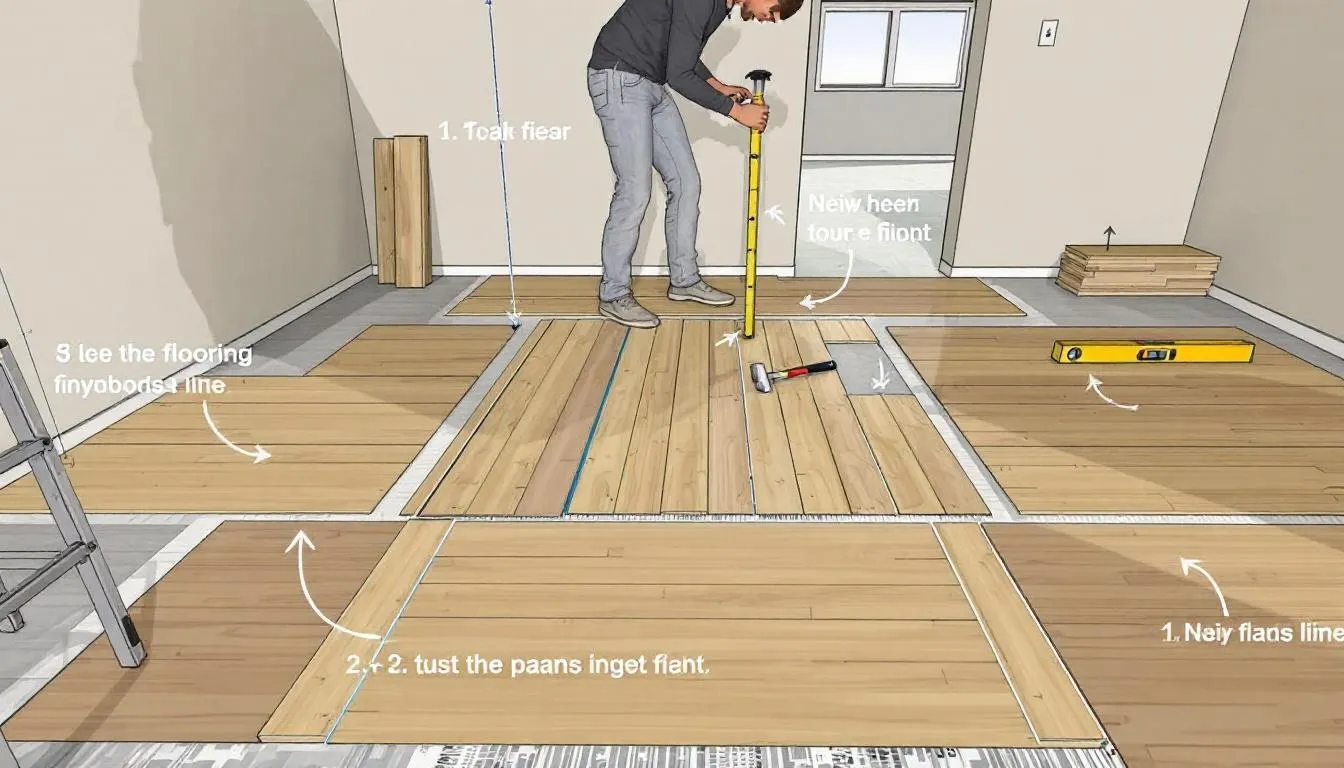What is the Process of Installing Wood Floors: A Step-by-Step Guide
Ahmad Fulkamarine • June 11, 2025

Installing a wood floor is a rewarding project that can transform the look and feel of any space. Whether you’re considering solid wood flooring, engineered wood flooring, or even laminate flooring, understanding the basics is essential for a successful outcome.
Step 1: Choosing the Right Wood Type
In Malaysia’s humid climate, engineered wood flooring is often preferred over solid hardwood due to its superior stability and resistance to warping. Some popular options include:
- Merbau – Durable with a rich, reddish-brown hue
- Kempas – High hardness and bold colour
- Bamboo – Eco-friendly and moisture-resistant
💡 Tip: Always select wood that is kiln-dried and treated to handle tropical humidity.
Choosing thicker wood planks can also improve sound insulation and enhance durability — especially useful in multi-storey homes and condos.
Step 2: Planning, Site Preparation & Moisture Testing
Proper planning and preparation are essential before installing any wood flooring. A smooth and long-lasting installation begins with inspecting the subfloor. Look for any loose boards, cracks, or uneven surfaces — these issues can affect the stability of your new floor.
Next, check that the room’s humidity level falls within the recommended range for your selected wood type. This is especially important if your space includes underfloor heating, as sudden temperature or moisture changes can lead to warping or gaps.
Moisture testing is a critical step. It helps detect hidden dampness in the subfloor that could damage your timber over time. In Malaysia’s humid climate, installing a moisture barrier or using damp-proof underlay is often necessary to protect against mould and swelling.
By investing time in proper site preparation, you’ll reduce the risk of costly issues and ensure your new wood floor performs beautifully for years to come.
Step 3: Tools and Equipment Needed
Having the right tools and equipment is key to a smooth and successful wood floor installation. Depending on your chosen method—whether it's a glue-down installation or a floating floor system—you’ll need specific tools to complete the job efficiently and accurately.
Common tools include:
- Hammer
- Saw
- Tapping block
- Measuring tape
For engineered wood flooring, you may also need a specially designed underlay to ensure a level surface. When using the glue-down method, choose a high-quality adhesive for a secure and lasting bond.
To stay safe and work efficiently:
- Wear gloves when handling wood planks and tools to avoid splinters or injuries
- Keep your tools organized and ready before you begin
By preparing all necessary tools in advance, you'll ensure a
precise, professional-looking installation and reduce the risk of delays or costly mistakes.
Step 4: Installation Method
There are 3 common ways to install wooden floors, suitable for hardwood flooring as well as engineered options, in Malaysian homes:
- Floating Floor – Planks are clicked together and laid over foam underlay. This floating installation is fast and easy, allows for easier replacement of individual planks, and requires a specific underlay designed for floating floors.
- Glue-Down – Ideal for concrete subfloors, this method offers strong adhesion when using high quality glue, ensuring durability and long-lasting hold for your hardwood flooring.
- Nail/Staple Down – Used mainly for plywood subfloors; rare in high-rise condos.
Your installer will help choose the best method based on your home’s structure and location. For proper laying of the floor, following instructions from the manufacturer is crucial.
Step 5: Cutting and Fitting the Wood Floors
Cutting and fitting wood flooring is a crucial stage that demands precision and care. Start by measuring the room’s width to determine how many full rows of planks are needed. Mark your cutting lines using a pencil, and always cut with the decorative surface facing upward to prevent chipping.
To ensure clean, accurate cuts:
- Use a carpenter’s square and straightedge for straight cuts
- Use a jigsaw for curved or detailed sections, especially around corners or doorways
Don’t forget to leave expansion gaps along the room’s perimeter. These gaps allow the wood to naturally expand and contract with humidity, particularly important for wider rooms or solid hardwood floors.
By measuring accurately and cutting each plank to the correct size, you'll achieve a seamless, professional finish that enhances the natural beauty of your flooring.
Step 6: Finishing Touches & Cleanup
Once the floors are in place:
- Skirting boards are installed.
- Finishing profiles are added to provide a seamless transition and polished look between the flooring and walls or other surfaces.
- Floor gaps are filled (if needed).
- When installed correctly, the wood planks will fit perfectly together for a professional finish.
- A final clean-up ensures your home is ready to enjoy and the installation is complete.
Some installers offer post-installation advice on
proper wood floor maintenance, which is important for long-term durability in Malaysia’s weather.
Step 7: Maintenance and
Upkeep of Wood Floors
After installation, proper care is crucial to protect your wood floors and maintain their appearance for years to come.
Daily & Weekly Cleaning Tips
- Sweep with a soft-bristled broom or use a vacuum with a floor brush attachment to remove dust and debris.
- For a deeper clean, use a damp (not wet) mop. Excess moisture can damage both solid hardwood and laminate surfaces, especially in Malaysia’s humid environment. Polishing & Protecting the Finish
- Apply a wood floor polish every few months to restore shine and add a protective layer to the surface.
- Avoid harsh chemicals or abrasive scrubbers that may strip the finish or scratch the wood.
Scratch Prevention
- Use felt pads under furniture legs to reduce dents and scratches.
- Place rugs or mats in high-traffic areas and near entrances to protect against wear and dirt.
Addressing Minor Damage
- Minor scratches or scuffs? Use a touch-up marker or wood filler to quickly repair them.
- For larger dents or damage, consult a professional before attempting any refinishing work.
By staying consistent with your cleaning and protection routines, your wood flooring—whether hardwood, engineered, or laminate—will remain beautiful, functional, and resilient for years, even in Malaysia’s challenging climate.
Final Thoughts: Is It Worth It?
Wood floors may cost more upfront compared to tiles or vinyl, but they add serious value, comfort, and aesthetic appeal to any Malaysian home. When properly installed and maintained, they can last decades, even in our tropical climate.

Need Timber That’s Perfect for Your Flooring Project in Malaysia?
At Resilient Timber Flooring, we don’t just supply timber — we help Malaysians lay the foundation for beautiful, long-lasting wood floors.
Whether you're installing hardwood in your home, office, or commercial space, we provide everything you need to get it right from the start:
- A wide selection of hardwood and engineered timber ideal for Malaysia’s climate
- Expert guidance on choosing the right timber based on your design and usage needs
- Ethically sourced materials with full sustainability certifications
- Fast delivery across Peninsular Malaysia
- Friendly, knowledgeable support at every stage — from supply to aftercare
We understand that every installation starts with a smart timber choice. Let us help you make the right one.
Visit resilienttimberfloor.com or email us today to get started with a reliable timber supplier in Malaysia.

Need Expert Advice for Your Space?
Choosing the right flooring isn’t just about materials — it’s about lifestyle, space, and future plans.
Let our flooring specialists guide you through the options. Whether you’re upgrading a single room or redoing your whole house, we’ll help you find the perfect wood flooring to match your vision and budget.
👉
Book a free consultation today
👉
Solid wood collections here
Your dream floor is just one click away.

Leave a Reply
Your email address will not be published. Required fields are marked *

